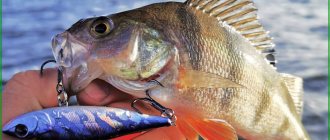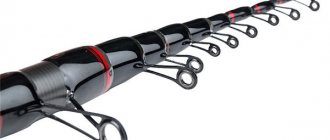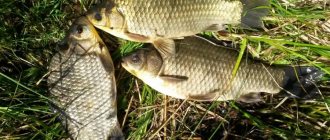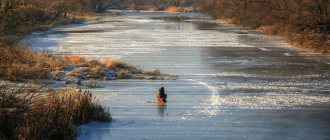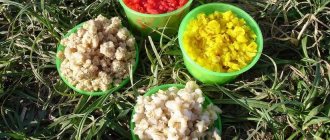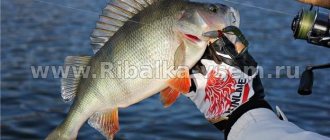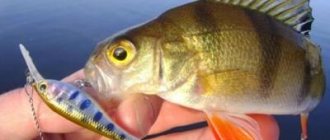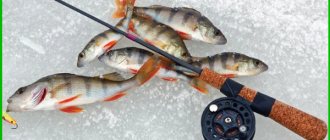Float tackle for perch fishing
Content
When fishing for perch, you can use any type of float rod - fly rod, match rod, Bolognese rod or plug rod. Of course, each of them has its own advantages and disadvantages.
Fly fishing rod
A telescopic fishing rod with a blind rig is used both in shore fishing and in fishing from a boat. Well known to everyone, simple and convenient, the fly rod allows you to catch almost any fish. Its significant disadvantage is the short casting range. When fishing from a boat, it is better to use rods 4–5 meters long, and for fishing from the shore – a rod 5–7 m long.
Fly rod for catching perch
Match fishing rod
The match fishing rod is designed for long-cast fishing. Its area of application is fishing for small fish in shallow reservoirs with standing water or weak currents.
It is better to catch perch for the match in lakes, ponds and bays with extensive coastal shallow waters. They are usually caught with a match rod using a worm or maggot. More delicate baits, such as whitebait, are often damaged when they hit the water or are torn off when casting hard.
Bolognese fishing rod
The Bolognese fishing rod is a telescopic rod 5–7 meters long with guide rings and a spinning reel. This is probably the best option for catching perch. Despite the fact that the main purpose of the Bolognese fishing rod is fishing with a retrieve in the current, it allows both long casts and short-range fishing.
Plug fishing rod
Plug fishing rods appeared relatively recently. These are float rods from 8 to 18 meters long with shortened blind equipment. The technique and tactics of fishing with a plug fishing rod are fundamentally different from fishing with other float gear. The niche for using a plug fishing rod is sports competitions and reservoirs with a free area for maneuvering the rod.
Despite a number of advantages, using a plug specifically for perch fishing is unjustified.
Read more
Which float to choose for fishing in the current?
Plug fishing rod for perch
Advantages and disadvantages of using side rods
Side fishing rod - Designed for vertical fishing and for this reason has modest dimensions. The material of manufacture is unimportant; fishing often takes place using a fishing line. Among the advantages it is worth highlighting:
- Price - onboard fishing rods have affordable price tags, and can also be made with your own hands without any problems
- Size - small dimensions allow you to install several of these fishing rods and at the same time fish together, they will not take up much space
Despite certain advantages, they are not without disadvantages, which include:
- Limited functionality - such a fishing rod cannot be used from the shore due to the peculiarities of its design. Maximum - embankments and marinas
- Depth - the onboard fishing rod is designed for fishing at a depth of three meters. With less, the bream simply will not be under the boat, which means casting vertically will not be particularly effective.
- Difficulties on the wave - Without the special designs described above, even a small wave can make it significantly more difficult to track the bite
Read How and what to catch asp at different times of the year
The onboard fishing rod is compact and easy to carry and transport. Another undeniable advantage of such gear is that it’s easy to make an onboard fishing rod with your own hands. It will not take much time and will not require large expenses.
Usually they fish with two or three side rods at once, in which case the catches are better. Accordingly, you need to make several gears at once. Another option is to make one fishing rod as a test, test it in action, make sure everything is in order with it, and then make more.
Equipment used
Float rigs for perch fishing are quite simple. They use monofilament lines with a diameter of up to 0.18 mm and floats with a weight of one and a half to four grams (when fishing with live bait up to 10–15 g). The type and shape of the float depends on the conditions and fishing method. Hooks are used with a straight and long shank. It is better to avoid using metal leashes.
Although the perch is not particularly careful, it is better to use the lightest possible equipment. This increases both the comfort of fishing and the number of bites.
What do perch bite on?
Most often, the striped predator can be caught with a worm, although some fishermen successfully practice fishing with maggots. It is advisable to place the whole worm on the hook; to catch large trophy specimens you will need a bunch of “living creatures”.
Advice! Pierce the worms in several places before placing them on the hook. The smell of the bait spreads quickly in the water and causes an immediate reaction from the predator.
In October, perch’s attention can be attracted by its natural food – small fish or live bait. When fishing with fry, they are hung on a single hook or tee. The following inhabitants of reservoirs can be used as live bait:
- gudgeon;
- bleak;
- rudd;
- perched water;
- small crucian carp.
Photo 3. Perch live bait - high water.
During summer fishing with live bait, small fish are chosen, this is especially true when hunting small predators.
So the length of the crucian carp should not exceed 4 centimeters. When choosing live bait for perch, many fishermen prefer bleak, topwater or gudgeon. It is recommended to place the fry in the area of the dorsal fin. The sting of the hook can come out, the perch is not afraid of this. In such a case, the likelihood of catching a predator increases.
Baits for catching perch
Perch is a predator, so catching it with baits of plant origin is almost impossible. But in relation to living organisms, perch professes the principle “everything that fits into its mouth is useful.”
The following baits are used when fishing for perch:
- Bloodworms are one of the best baits because they are natural food for both perch and many other fish. When fishing for perch with a float, it is used in early spring and late autumn.
- Maggot – usually used in summer. Like bloodworms, it is a universal bait.
- A caddisfly larva that lives in streams and the coastal zone of rivers.
- Leech – both horse leeches and small clepsin leeches are used.
- Mormysh is an amphipod crustacean that resembles a tiny shrimp.
- The larva of a dragonfly, which is best caught in late spring and early summer - before the mass flight of dragonflies.
Perch can also be caught using tadpoles in the summer and frogs in the fall. But by far the most popular baits for bass fishing are worms, minnows and live bait.
Bloodworm is one of the best baits
Where and how to catch perch in the summer with a fishing rod
The habitat of perch is all reservoirs suitable for fish with clean water and a well-developed food supply (vegetation, small animals, insects, etc.). These can be large rivers, and very small lakes, ponds, etc. This is explained by the fact that perch is an omnivorous inhabitant of water bodies - it hunts everything that moves and lives in the water column.
The most successful time for fishing for perch is the summer season, but in this case, it is worth considering that in hot weather, when the water column of the reservoir is very warm, this small predator stops hunting, like many other species of reservoir inhabitants.
Its body temperature rises according to the environment, and it strives to cool down and sinks to depth. But a completely different picture can be observed in the summer at dusk and late in the evening: the predator becomes active again and begins to eat everything that gets in its way. Perch also shows off a good appetite on cloudy days or in calm, cool weather.
If you go fishing with a fishing rod equipped with a regular float, then you should choose a place for fishing on a river or lake that is not very overgrown, and ideally, so that the hook does not get tangled or cling, areas without vegetation.
Also, using such a simple tackle as a fishing rod with a float will be very convenient in places with shallow depths (up to 3 meters) - and perch likes to hunt in such places, because there, most often, an impressive food supply in the form of fry and fallen fish is concentrated there. insects on water.
Perch is found almost everywhere in Russia, in ponds, lakes, and rivers. Its character is unpredictable; when fishing, it can show all its temper, which undoubtedly pleases fishermen. The process of catching it is exciting; it is a desired trophy for everyone. The habitat of perch in different bodies of water sets different characteristics in behavior. It usually lives in schools; the smaller the individuals, the larger the school of fish.
Perch is found almost everywhere in Russia, in ponds, lakes, and rivers. Its character is unpredictable; when fishing, it can show all its temper, which undoubtedly pleases fishermen. The process of catching it is exciting; it is a desired trophy for everyone. The habitat of perch in different bodies of water sets different characteristics in behavior. It usually lives in schools; the smaller the individuals, the larger the school of fish.
Perch behavior
The bite on the river does not stop throughout the day, but large individuals are mainly caught only at night. But in ponds where the water is stagnant, perch prefers to sit in the shade during the daytime; perch fishing is possible only in the early morning hours.
Habitats
Active biting calendar
For successful fishing, it is not enough to stock up on gear, bait and patience; you also need to know the time of active biting, and what weather conditions affect its behavior.
Gear selection
The main gear used when fishing for perch is a float rod and a spinning rod.
Using a float rod will not bring the same excitement as a spinning rod, especially since for a positive result you need to know the exact topography of the bottom. Choose a rod no more than 4 meters in length. The line should be thin, but count on catching large fish; the optimal line diameter is 0.10 mm. The float should not be too long with a narrow keel, this will help to see even small fluctuations.
The minimum sinker is selected, such that it can withstand the carrying capacity of the float. Choose a hook with a long shank, this guarantees that the fish will not escape. Among the baits, perch prefers maggots, bloodworms, and dung worms.
Spinning tackle must weigh no more than 11 grams. Choose a good friction reel with smooth running and easy line reeling. For the tackle, choose a fishing line with a thickness of 0.13 mm, a pear-shaped weight and offset hooks of various sizes. For the leash, use fluorocarbon fishing line. Bait in the form of a twister is selected taking into account the size of the perch living in the pond.
Having baited a leech on a hook, I threw the fishing rod into the place where the fish had recently been well received... the float, jumping twice, sharply went under the water and a good perch was on the hook. A good crucian carp went to the garden for the perch. This is what the fish collected under the water lilies! “Why not try a leech now?” a good thought flashed through my head. I took a small box, put wet grass in it and climbed into the river to collect small leeches, several of them nestled under each leaf of a thick water lily.
There is an opinion among fishermen that perch is an omnipresent fish and will take anything that is hooked. Even the fishing classic L.P. Sabaneev wrote that perch fishing is the easiest and best-performing activity, and therefore there are a lot of fans of this type of fishing, especially among beginners and young fishermen. And there are times when not even a perch is caught. This can happen with a sudden change in atmospheric pressure, prolonged heat, or a couple of days before a sudden change in weather.
It is one of these periods that occurs during a significant part of the summer and the beginning of autumn, when the heat outside is unbearable. At this time, perch can only be caught early in the morning and in the evening at sunset. What can fishermen do all day?
Struggling with the lack of fish, I involuntarily remembered an interesting episode of last year’s fishing, when early in the morning my father and I caught perch and crucian carp with float rods in June using a dung worm. It was biting well: time after time, together we pulled out good crucian carp and perch into the light of day, and suddenly the fish stopped taking the bait.
We began a lively discussion about the reasons for the cessation of the bite, during which I accidentally drew attention to the water lilies, under which a fish appeared from time to time, moved it, and then disappeared into the depths. The question hung in the air: “What do fish collect from water lily leaves?” Without hesitation, I pulled one of the leaves out of the water and looked under it. There was a small red leech there. The old fisherman’s advice that a leech is great for catching a variety of fish came out of my memory.
Having baited a leech on a hook, I threw the fishing rod into the place where the fish had recently been well received... the float, jumping twice, sharply went under the water and a good perch was on the hook. A good crucian carp went to the garden for the perch. This is what the fish collected under the water lilies! “Why not try a leech now?” a good thought flashed through my head. I took a small box, put wet grass in it and climbed into the river to collect small leeches, several of them nestled under each leaf of a thick water lily.
The red disk of the sun slowly rolled down to the horizon, and the day slowly turned into evening. A thick white fog rose over the river. Upon returning home, I was replaying in my memory the successes and failures associated with the striped “familiar stranger” that happened today. Satisfaction with a successful experiment gradually developed into a feeling of fatigue and good appetite. How wonderful it is when you set a goal for yourself and manage to realize it so quickly and successfully.
Fishing with summer girders is possible on sections of the coast where steep slopes or coastal holes are identified. The bait is equipped with an additional weight, the weight of which will hold the fish in the bottom layer of water. The length of the leash should ensure free movement of live bait above the bottom surface. 30-50 cm is enough.
Catching perch with a worm
To catch perch, you can use either a crawler or a bunch of dung worms. And when catching small perches, they use one small worm or even a piece of it. They impale the worm with an accordion, piercing it several times starting from the head. The hook tip is left open.
Fishing is carried out in perch hunting areas:
- at the border of aquatic vegetation;
- on coastal dumps;
- in a snag, or directly next to it;
- near various hydraulic structures.
They begin fishing by lowering the worm to the very bottom, and if there are no bites, they gradually reduce the fishing depth. If there are no bites even in the water column, it is better to change the place.
Lures for perch in summer
Today there is an insane variety of artificial baits that allow you to catch perch in the summer. These include cicadas, spinnerbaits, spoons, wobblers, and all kinds of silicone baits. Let's look at the most popular of them.
[THERE IS AN ANSWER] How to tie a jig on a winter fishing rod?
Spinner spinners. A true timeless classic of fishing life. It is worth working carefully with the choice of color and shape of such baits. Thus, the natural tones of such spinners are relevant in clear water during daylight hours, and bright colors are relevant in rain, evening fishing and when working in muddy areas.
Spinners. Catching perch in summer is effective with small baits, the length of which does not exceed 5 cm. Oscillating spoons are most effective if used in fishing from the bottom. The perch will definitely respond to the bait by diligently searching for something along the bottom.
Such baits work well at depths where large individuals hide. Here it is important to guess the size, otherwise the fish will find this bait too tough. An arsenal of bait and experimenting with it at the fishing spot will help.
You can catch perch with a float rod both from a boat and from the shore. During fishing, they catch all interesting areas of the reservoir, carefully and quietly making their way to them.
Catching perch with fry
Malek is a fish up to 35–40 mm long. Juveniles of low-value fish - verkhovka, bleak, roach - are used as bait.
To catch perch with fry, it is better to use a Bolognese fishing rod 5–6 meters long, equipped as follows:
Read more
How to catch grass carp with a float rod?
- main line with a diameter of 0.16–0.18 mm;
- float with a load capacity of up to 3–3.5 g;
- the sinker must be selected in such a way that the float is slightly underloaded, otherwise the fry will recess the float antenna, creating the illusion of a bite;
Catching perch with fry
- a leash 20–25 cm long and with a diameter two hundredths of a millimeter smaller than the main fishing line is attached through a small swivel;
- A single hook with a long shank made of thin wire is used, as it injures the fry less.
It is better to bait the fry by the upper lip or through the nostril.
Otherwise, fishing for fry is no different from catching perch with other baits.
How to catch perch with a float rod
Arriving at a pond, the angler chooses the most promising place for fishing, prepares a bait mixture and sets up the tackle. Before setting the bait, the fisherman sets the release of the float so that the hook is 2–5 cm from the bottom. After setting the working depth, the angler baits the hook, throws the equipment and throws 2-3 balls of bait the size of an orange at the fishing point.
If within a few minutes the fish has not shown itself in any way, you should experiment with the fishing depth, reducing the descent of the float. If there is no bite, you need to change the type of bait. If manipulations with changing the fishing horizon and changing bait do not bring results, then you should move to another place.
Catching perch with a fishing rod is a constant experiment involving the search for the optimal composition of the bait mixture, selection of the required depth and choice of bait.
Bait for perch
Few anglers use bait to catch perch. In the literature there are references to attracting perch to the fishing site by feeding forage fish, but this method is only suitable for regular fishing in the same place.
Today, a number of manufacturers produce bait for perch fishing. Unfortunately, it is not often on sale. An improvised replacement for branded baits can be homemade bait, including:
- dry blood,
- fish or meat and bone meal,
- dried daphnia or gamarus (mormysh).
Attractants can be used in bait to catch predators.
Where to catch big bass?
The larger the perch, the less prone it is to schooling behavior. Trophy perch are individualists. They live in deep, cluttered holes with a hard bottom and are often found near piers and dams. In large rivers and reservoirs, large perch can be found on the dumps of shoals located far from the shore. It’s better if there are zebra mussel colonies on the bottom where you’re fishing. Large perch come out to feed during dawn and dusk.
Trophy perches are individualists
Using float tackle, it is better to catch large perch using live bait. The size of live bait for large perch is 8–12 cm. Live bait is attached:
- during the current - behind the nostril;
- in standing water - carefully behind the back so as not to damage the spine.
Fishing for perch with a fishing rod near bridges and dams
Artificial structures attract perch both in currents and in still water. In rivers it can be caught by rigging near piles and bridge supports, where the perch is sheltered from strong currents.
Fishing near dam drainage can also be effective. The water flow carries food particles that attract small fish that perch prey on. Here it is better to catch it with a Bolognese fishing rod for fry, floating a float at the border of fast and slow currents.
It is also convenient to fish by floating small fish from the bridges of small rivers and large streams. This allows you to fish a large area from one place.
Read more
How to catch tench with a float rod?
Choosing a float for fishing in the current
Exposure to water flow can change the behavior of the float beyond recognition. That is why for river fishing it is recommended to choose special floats suitable for use in currents.
If you are used to fishing in still water, then you have already appreciated the advantages of goose feather and needle floats. With a current, even a slight one, such structures will be completely ineffective - the waves roll them over to one side and, as a result, the floats lie almost parallel to the water surface. Current fishing conditions require a special approach to choosing a float, starting with its design to optimally reduce the negative influence of waves
It is worth paying attention to universal options with the following features:
- egg-shaped (or pear-shaped) with a thin long rod and 2-3 attachment points;
- the body of the float should be located closer to the top edge (serves as a control element);
- the antenna should be much smaller in size than the keel (this will allow the structure to be kept in an upright position even with overactive currents).
It is very important to correctly decide initially on the shape of the body of the float, which will become universal for use in the current, even in windy weather conditions. Drop-shaped models with short antennas meet these characteristics.
Flat floats
Relatively new fishing bite alarms, which have already gained incredible popularity, in particular among fans of plug rods. The almost perfect hydrodynamic shape reduces water resistance to the minimum possible. Even in such powerful currents as on a mountain river, the flat float takes the desired position, remains in an upright position and signals even the most cautious bites.
A flat float made by yourself is not inferior in quality to a purchased one. Important! The main features of flat floats are a flat body, similar to a disk (it turns with an edge towards the current and, as it were, cuts it, significantly reducing resistance) and a keel installed at an angle (under the influence of the current, it does not allow the structure to heel, keeping it in a vertical position).
Initially, this type of float was recommended only for rivers with active currents
Appropriate loading made it possible to use them in a wide variety of conditions, including in still water when fishing for even the most cautious and timid fish in calm weather and in rain
Choosing a float depending on the intensity of the current
When trying to catch trophy river fish, it is necessary to take into account all the nuances. One of the subtleties is the correct selection of the weight of the float for flows of different speeds/intensities. In this case, the following recommendations will be useful:
For weak current
Floats that can withstand a load of 4 to 8 grams are suitable. It is very important to pay special attention to loading, using heavy and light pellets at a distance of at least 20 cm from each other. In this case, the bait smoothly sinks into the water without scaring the fish and at least 10 cm the leash should lie quietly on the bottom. With such equipment you create conditions under which it is easy to notice bites from even the most cautious individuals of chub, roach and ide. For middle flow
You will need a float with a carrying capacity of 6 to 20 grams, which should be used with a leash of at least 60 cm and no more than 150 cm in length (it is assumed that most of it will lie on the bottom). When loading the pellets, it is necessary to place them closer to the leash and make the distance between them no more than 10 cm. Such equipment in the middle current holds the float in a comfortable vertical position and will promptly notify you of bites from carp and bream. For strong currents. It is necessary to use a stable float with a load capacity of 8 to 40 g. The length of the leash increases to two meters and the pellets are moved closer to the bottom of the main line during shipment. In order for the finished equipment to be carried away by the current as slowly as possible, it is recommended to hold the spool with your finger when casting and after it, or even block it with the reel bail. This option is great for catching large carp and bream.
Such recommendations can be considered general, combining the main principles of fishing in the current. To get the desired catch, it is better to experiment not only with the bait, but also with the equipment - to quickly remove and replace it, use a mount with micro-swivels.
Read How to choose feeder rods for a beginner
Perch fishing in snags
Snag is one of the favorite habitats of perch. However, fishing in it leads to constant snagging and broken gear. It is better to fish with a float rod not in a snag, but next to it. This type of fishing is especially successful during moments of feeding activity, when perch leaves cover in search of food.
If the perch refuses to leave the snag, then it is better to catch it with other gear - either with a spinning rod with no hooks, or with a fishing rod with a side nod.
Perch fishing in bays
Fishing for perch in bays and among thickets
In bays, oxbows and lakes, perch is caught on the border or in windows of aquatic vegetation. To fish with a float, you can clear a small area of thickets yourself. Of course, it will not be possible to fish in it immediately, but at least after a few hours, when the frightened fish return to their resting places.
The best baits for this type of fishing are a worm, a leech and a whitebait. Perch can bite in such places both at the bottom and at the very surface of the water. Fishing with a slow-sinking bait is often effective. This can be achieved by moving the sinker towards the float itself.
Catching perch on a coastal dump
Only small perch constantly stay on coastal dumps. Larger perches approach the shore only in raids in search of fry. This usually happens early in the morning.
The fishing spot is easy to find by the characteristic action of the perch. If there are no visual manifestations of perch, then it is better to look for it in places of channel and bottom anomalies:
- at the mouths of flowing rivers and streams;
- at steep edges;
- near coastal capes and spits.
It is better to fish without going close to the water, so as not to scare the perch. The second (even better) camouflage option is wading fishing - the deeper the fisherman goes into the water, the less the fish is afraid of him.
Catching perch near landing stages
In the summer heat, perch can be found near piers, pontoons and landing stages. It is better to fish close to the side of the landing stage or at the border of the shadow cast by it.
More often the perch bites at the bottom, but if there are no bites, you need to fish the entire thickness of the water. If the depth at the fishing spot exceeds the length of the rod, you can use a sliding float.
In addition to perch, other fish are often found near the landing stages - from ruffs to bream and pike perch, which certainly adds interest to fishing.
Originally posted 2018-03-02 10:14:39.



